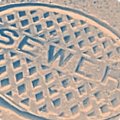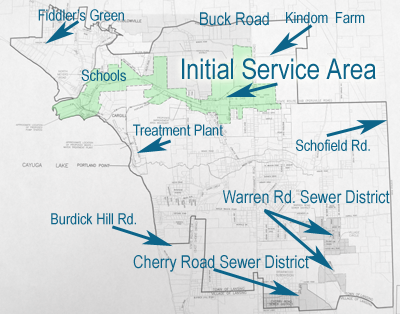- By Dan Veaner
- News
 Print
Print 
| Thanks to four eagle-eyed readers who noticed extra digits in two of the numbers presented in this article Friday. The numbers were corrected Satrday morning. | ||
Last week engineer David Herrick presented a map showing a chunk of the Town that has water service now. While not all properties within the consolidated water district are included in the sewer district, the water district helps define a portion of the proposed sewer area that will not be in the initial sewer service area, but will be eligible to receive service in the future.
In order to begin calculating costs to property owners, Herrick gathered numbers on the value of the properties within the proposed district. The total property value is $388,982,382. After adjusting for the actual taxable value, he came up with a conservative estimate of $319,869,082. The lower number reflects the way agricultural and not-for-profit lands are taxed.
That suggests that an annual sewer fee would come to about $10 per $100,000 of property value in an annual fee if a simple flat rate were applied. However, that approach is not being considered.
Instead the committee prefers a three-tiered approach in which the people actually receiving service pay more. Herrick presented three formulas for the committee to consider. Formulas split costs 50%/30%/20%, 60%/35%/5%, and 60%/39%/1% with the first number in each representing the percentage paid by people in the benefit area who are hooked up, the second represnting properties within both the sewer and water districts but outside of the initial benefit area, and the third encompassing properties outside of the water district and benefit area but within the sewer district.
Those in the first tier would get sewer service right away, those in tier two are most likely to get sewer in the future, and the third tier is within the sewer district, but less likely to get service.
 Sewer committee members look at a map of the potential sewer district showing three tiers of billing, including the initial service area, properties outside that area that currently fall in the water district, and properties outside the water district but inside the sewer district
Sewer committee members look at a map of the potential sewer district showing three tiers of billing, including the initial service area, properties outside that area that currently fall in the water district, and properties outside the water district but inside the sewer district Committee member Noel Desch said that third formula is 'in balance', saying it is the fairest approach and the most defensible. But the committee has to set a formula for charging district property owners before the Town Board can approve a Public Interest Order that will begin the process that eventually will lead to a vote on creating the sewer district.
The Map Plan Report for a much smaller district that only included the initial service area was nearly complete in September, but committee members and town officials feared that it would be too expensive for residents of that area to pay for. At that stage the committee explored a town-wide plan, and settled on a partial town plan based on maps prepared for earlier sewer projects that Herrick noted make sense from an engineering standpoint. The idea is that areas that already have water service are sewerable.
Committee members asked Herrick to begin work on an updated Map Plan Report based on the 60%/39%/1% approach. In that approach initial estimates are that those in tier one would pay about $522 annually, including O&M (Operation and Maintenance) fees. Usage charges would be based on water usage. Tier two properties, within the consolidated water district, but outside the initial sewer service area, would pay about $49 per $100,000 of property value, and those outside the sewer improvement areas and consolidated water district about $9 per $100,000.
A minimum quarterly charge for those properties hooked up to the sewer is also being considered. None of these numbers are set yet, and while annual fees will likely go up over the years, new construction, especially that projected for the town center, will spread the obligation, lowering costs for everyone.
Lansing Councilman Ed LaVigne warned that any numbers being discussed are not the final costs to property owners. LaVigne said he and other board members have been approached by property owners worried about the cost of sewer, and confused about whether their property is included in the district.
"Until we have a map plan report, until we have an official number there is nothing to be said," LaVigne said. "Anything that's written is only speculation at this point."
 Proposed sewer district
Proposed sewer districtLaVigne said he has been getting pushback from people outside the sewer district that are part of the town's consolidated water district, particularly in north-west Lansing.
"This is one of the questions someone asks you," LaVigne said. "If I have water going by me that goes to the power plant, am I going to be stuck paying for something I'm not going to get? The answer is you're not going to be stuck because you're not in the sewer district."
Only property owners within the sewer district will have a vote on whether to form it. If the board decides on a permissive referendum ten percent of those voters would have to present a petition to trigger a vote. But board members say they favor a fixed referendum over a permissive referendum, saying they have been promising that district property owners will get to vote on sewer and simply holding that vote will get in front of the issue.
The committee also discussed the cost of hooking up to the sewer. Officials are hoping to find grants to help families in need to hook up, and the committee discussed the possibility of the town or the district creating a fund to help such families. They also discussed equipment such as grinder-filters, saying that the town should stock them for purchase by property owners to insure that the sewer has the right equipment that will work and make installations simpler to service.
While LaVigne says that the numbers in the 60%/39%/1% are not officially approved numbers, the committee asked Herrick to use that formula in rewriting the Map Plan Report. As the report comes closer to a final draft the committee will decide whether the numbers are acceptable. The report must be completed with the final financial formula and sewer district boundaries set before the initial Public Service Order can be approved by the Town Board.
Town Attorney Guy Krogh said that if a Public Service Order can be approved in February it will be several months before a sewer district could officially be formed. He said in the best case scenario the final step in forming the district would come around May, but noted that unforeseen delays should be expected.
v8i47



